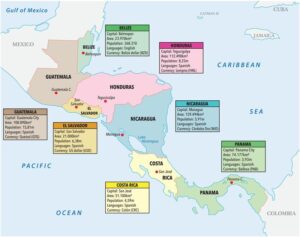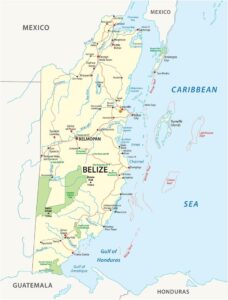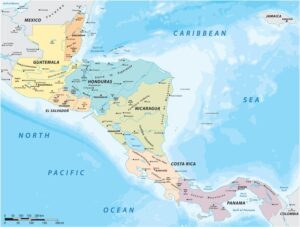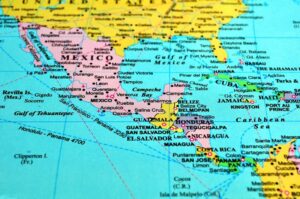Over the centuries, the territorial boundaries of Belize have been shaped by a complex and contentious historical narrative. You may find yourself wondering why the border between Belize and Guatemala appears as a dotted line on many maps, a visual indication of a long-standing territorial dispute. This ongoing conflict can be traced back to historical claims put forth by Guatemala, which has consistently contested Belize’s sovereignty since its independence. The potential for international tension remains a critical issue, as both nations are actively engaged in diplomatic negotiations aimed at resolving this boundary dilemma. Your exploration of this geopolitical issue unveils the intricate challenges surrounding national borders in Central America, where colonial legacies and concepts of territorial integrity frequently intersect, often in potentially volatile ways.
Delving into the Historical Claims of the Belize-Guatemala Territorial Dispute
The ongoing territorial conflict between Belize and Guatemala has deep roots in complex historical and colonial legacies. This dispute harks back to the colonial era when boundaries were frequently ill-defined and subject to interpretation. The unresolved border issue has persisted for centuries, leading to ongoing tension between these neighboring countries and impacting their diplomatic relations significantly. As you explore this conflict, you will uncover how historical grievances and territorial definitions have evolved, creating a landscape of misunderstanding and mistrust that complicates both nations’ current interactions.

Unpacking Guatemala’s Long-standing Territorial Claims Over Belize
Primarily, Guatemala has maintained a longstanding assertion of territorial rights over Belize, fundamentally rooted in the Spanish colonial administrative boundaries. It may come as a surprise that Guatemala views Belize as part of its original territorial inheritance from the Spanish Empire, thereby challenging the modern borders that were established during the era of British colonial dominance. This historical viewpoint continues to stoke Guatemala’s claims, further complicating the issue of sovereignty and contributing to ongoing tensions between the two nations.
Assessing the Implications of Historical Borders on Modern Diplomacy
Since the colonial period, these disputed boundaries have fostered significant geopolitical challenges for both Belize and Guatemala. You can witness how undefined border regions create a potential for conflict and diplomatic tensions, which directly impact local communities and national sovereignty. Gaining insights into the border dispute reveals complex layers of historical, legal, and territorial dynamics that shape contemporary relations. The implications of this disagreement extend well beyond mere geographical lines, encompassing economic, cultural, and security risks. The ongoing conflict has substantial ramifications for regional stability, international law, and the prospects for future negotiations between Belize and Guatemala.
The Importance of the Dotted Line on Maps in Reflecting Geopolitical Tensions
On various maps, you may observe a distinctive feature: a dotted boundary line between Belize and Guatemala, which symbolizes an unresolved territorial dispute that has persisted for decades. This unique cartographic representation indicates a complex geopolitical challenge, where the exact border remains undefined and highly contested. The dotted line serves as a representation of the ongoing diplomatic tension and the unresolved territorial claims that have been a hallmark of the relationship between these two Central American nations for years.
International Recognition and the Ongoing Border Dispute
Within the realm of international relations, Belize is recognized as a sovereign state with established international presence; however, the disputed border with Guatemala introduces a nuanced geopolitical scenario. It is noteworthy that while Belize achieved independence in 1981, Guatemala has historically contested its territorial integrity. The dotted line not only signifies geographical uncertainty but also represents an ongoing diplomatic negotiation that continually shapes regional relations and perceptions. Understanding this dynamic is essential for appreciating the complexities of their interactions.
The Diplomatic Significance Behind the Dotted Line Representation
Beyond its role in cartography, the dotted line acts as a significant diplomatic emblem. You might interpret it as a visual representation of unresolved territorial claims, signaling to the global community the intricate negotiations underway between Belize and Guatemala. This distinctive border marking conveys the ongoing dialogue and the potential for a peaceful resolution to the conflict. Yet, the dotted line embodies more than just a geographic curiosity; it serves as a delicate diplomatic instrument that helps mitigate potential military escalation while preserving open channels for negotiation.
This line functions as a strategic buffer, allowing both nations to maintain diplomatic relations and work towards a feasible future resolution. Its existence exemplifies how international borders can be managed through peaceful means, showcasing a sophisticated approach to territorial disputes that prioritizes dialogue over confrontation and fosters a more stable diplomatic environment.

Analyzing Key Conflicts and Diplomatic Agreements Between Belize and Guatemala
The territorial disputes between Belize and Guatemala are deeply entrenched in history, marked by complex diplomatic tensions and unresolved boundary claims. You’ll discover that the ongoing disagreement centers around conflicting interpretations of colonial-era treaties and the concept of territorial sovereignty. This dispute has far-reaching consequences for both nations, involving potential land ownership challenges and regional geopolitical dynamics that continue to shape their bilateral relationship.
Evaluating the Impact of the 1859 Treaty and Subsequent Developments
Before the signing of the 1859 treaty between Britain and Guatemala, territorial boundaries within the region were ambiguous and fiercely contested. It’s essential to understand that this agreement aimed to delineate clear borders, yet subsequent interpretations have led to ongoing disputes. Guatemala has persistently challenged the treaty’s validity, arguing that Britain failed to uphold certain commitments related to infrastructure development, which has become a central point of contention in their territorial disagreement.
International Court of Justice Involvement and Recent Diplomatic Efforts
Recent diplomatic initiatives have focused on resolving the protracted border dispute through international legal avenues. You’ll note that both nations have consented to present their case to the International Court of Justice (ICJ) for a binding resolution. This strategy signifies a notable advancement toward peaceful conflict resolution and the potential normalization of their bilateral relations.
In addition to the ICJ proceedings, it is essential to recognize the complex diplomatic negotiations that have occurred. The potential referendum in both countries aimed at validating the ICJ’s decision represents an innovative approach to resolving territorial disputes. Your awareness of this process underscores the delicate diplomatic efforts undertaken to maintain regional stability and address historical territorial claims through peaceful, internationally recognized mechanisms.
Understanding the Current Situation and Travel Considerations for Belize and Guatemala
Travelers are often captivated by Belize’s unique border configuration with Guatemala. The ongoing territorial dispute has generated a complex geopolitical landscape that impacts travel and border crossings. Despite the existing tensions, tourists continue to explore both countries, navigating the intricate diplomatic situation while considering international boundaries and local regulations. Understanding these dynamics is crucial for ensuring a smooth travel experience.
Essential Guidelines for Safely Crossing the Belize-Guatemala Border
When planning international travel to Belize, it’s vital to prepare thoroughly and consider these important guidelines:
- Ensure that you have a valid passport and any necessary travel documentation
- Check the current state of diplomatic relations before you embark on your journey
- Obtain suitable travel insurance for your trip to cover any unforeseen circumstances
- Stay informed about border crossing procedures to prevent complications during your travels
Above all, it’s crucial to remain aware of your surroundings and respect local regulations to ensure a safe and smooth travel experience across this culturally rich and politically complex region.
Community Perspectives and Local Sentiments Regarding the Border Dispute
At the heart of the border dispute lie deep-seated historical tensions and intricate cultural dynamics. Communities residing near the border directly experience the impacts of this dispute, with generational memories of conflict profoundly influencing their viewpoints. Residents navigate a delicate balance between national pride and a desire for peaceful coexistence, emphasizing the human dimension of this geopolitical issue.
Gaining Deeper Insights into Community Dynamics Along the Border
To fully comprehend the local perspective, you should delve into the nuanced landscape of cultural identity. You will discover that border communities have developed unique survival strategies, blending resilience with diplomatic pragmatism. Indigenous groups, in particular, play a pivotal role in maintaining cross-border relationships, frequently transcending official diplomatic tensions through grassroots connections and shared cultural experiences, thereby fostering a sense of unity amid conflict.

Future Implications of the Ongoing Belize-Guatemala Border Dispute
Despite the persistent territorial dispute, there exists significant potential for geopolitical shifts. The unresolved border issue between Belize and Guatemala continues to generate tension, with consequences that could reshape diplomatic relations in Central America. You might observe that resolving this dispute could have profound effects on regional stability, economic cooperation, and the international perceptions of both nations.
Continuing Dialogue and Negotiations Between Belize and Guatemala
Dialogue serves as the primary mechanism for addressing the territorial disagreement. You will find that both countries have engaged in diplomatic negotiations, striving to achieve peaceful resolutions through international platforms such as the Organization of American States (OAS). These discussions represent a commitment to avoiding military confrontation while seeking a mutually acceptable solution to their long-standing border dispute, emphasizing the importance of dialogue in conflict resolution.
Exploring Viable Pathways Towards Resolution of the Dispute
Above all, you should recognize that multiple strategies exist for resolving the border conflict. International mediation and bilateral negotiations are potential avenues for progress. You might see approaches such as joint territorial management, referendums, or interventions from international courts as effective methods to address the dispute constructively.
The implications of successfully resolving the conflict extend far beyond simple border demarcation. You will discover that effective negotiations could unlock significant economic opportunities for both Belize and Guatemala. Potential benefits could encompass enhanced trade, improved cross-border cooperation, and increased foreign investment. The most transformative outcome would be the establishment of permanent territorial sovereignty, which could dramatically reduce regional tensions and promote long-lasting stability in Central America.
Understanding the Regional Dynamics of the Belize-Guatemala Conflict
Unlike other border disputes in Central America, the Belize-Guatemala territorial conflict is steeped in deep historical complexities that have significantly influenced regional geopolitical interactions. You’ll find that this enduring disagreement reflects broader patterns of territorial tension involving colonial legacies, post-independence territorial claims, and intricate diplomatic negotiations that have profoundly shaped the political landscape of the region.
The Impact of the Dispute on Central American Diplomatic Relations
After decades of territorial disputes, you can observe how this conflict has strained diplomatic relationships between Belize and Guatemala. The ongoing tension has periodically disrupted regional cooperation, creating hurdles for economic integration and mutual understanding within the broader Central American community and affecting overall regional dynamics.
The Role of International Organizations in Mediating the Dispute
With diplomatic mediation playing a vital role, international organizations have actively engaged in efforts to resolve the border dispute. You’ll notice that entities such as the Organization of American States (OAS) have been instrumental in facilitating dialogue and proposing viable resolution strategies to ease tensions.
A comprehensive network of international organizations has been strategically involved in addressing the Belize-Guatemala border dispute. The United Nations, OAS, and various diplomatic channels have tirelessly worked to prevent escalation, offering mediation services and promoting peaceful negotiation solutions. You’ll appreciate how these organizations have helped maintain stability in the region, providing a structured approach to resolving territorial disagreements and mitigating potential military confrontations.
Reflecting on the Intricacies of the Belize-Guatemala Border Dispute
As we weave together the complex threads of Belize’s territorial history, you can see how the nation’s border with Guatemala remains a testament to unresolved colonial legacies. As you delve into this geopolitical puzzle, you’ll understand that the dotted border symbolizes more than a mere cartographic curiosity; it embodies ongoing diplomatic negotiations and historical tensions. Your grasp of this dispute unveils the intricate challenges facing post-colonial states, where territorial boundaries continue to ignite international dialogue. The unresolved status underscores the delicate balance between historical claims and contemporary diplomatic resolutions, inviting you to appreciate the nuanced complexity of international border disputes.

Frequently Asked Questions Regarding the Belize-Guatemala Border Dispute
What is the significance of Belize’s dotted border with Guatemala?
The dotted border signifies a long-standing territorial dispute between Belize and Guatemala, stemming from conflicts that date back to the colonial era. Spain initially claimed the territory, and after Belize gained independence from Britain in 1981, Guatemala continued to assert its territorial claims, leading to an undefined border demarcation represented by the characteristic dotted line on maps.
Has the border dispute between Belize and Guatemala reached any resolution?
The dispute remains partially unresolved; however, significant progress has been made. In 2019, both countries agreed to submit the territorial disagreement to the International Court of Justice (ICJ) for a binding resolution. A referendum in both nations endorsed this approach, indicating a diplomatic pathway toward definitively settling the border controversy.
What are the historical origins of the border conflict between Belize and Guatemala?
The conflict originates from the 1859 treaty between Britain and Guatemala, which promised infrastructure development in exchange for territorial recognition. When Britain failed to fully meet these commitments, Guatemala began challenging Belize’s territorial integrity. This historical misunderstanding has perpetuated decades of tension, with Guatemala maintaining claims over approximately 53% of Belize’s current national territory.
The Article Why Is Belize’s Border Dotted? Exploring the Guatemala Dispute appeared first on Belize Travel Guide
The Article Belize’s Border Dotted: Unraveling the Guatemala Dispute Was Found On https://limitsofstrategy.com


The complex history behind the Belize-Guatemala border truly highlights the lasting impacts of colonialism on present-day geopolitics. It’s fascinating, yet disheartening, to see how historical claims can continue to influence national identities and relations long after the colonial powers have departed. I wonder how much the younger generations in both Belize and Guatemala are aware of this historical context and how it shapes their perceptions of the neighboring country.